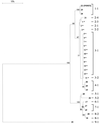Evaluation of fluorescence-based amplified fragment length polymorphism analysis for molecular typing in hospital epidemiology: comparison with pulsed-field gel electrophoresis for typing strains of vancomycin-resistant Enterococcus faecium
- PMID: 11060068
- PMCID: PMC87541
- DOI: 10.1128/JCM.38.11.4058-4065.2000
Evaluation of fluorescence-based amplified fragment length polymorphism analysis for molecular typing in hospital epidemiology: comparison with pulsed-field gel electrophoresis for typing strains of vancomycin-resistant Enterococcus faecium
Abstract
Fluorescence-based amplified fragment length polymorphism (fbAFLP) is a novel assay based on the fluorescent analysis of an amplified subset of restriction fragments. The fbAFLP assay involves the selective PCR amplification of restriction fragments from a total digest of genomic DNA. The ligation of adapters with primer-specific sites coupled with primers containing selective nucleotides allowed the full potential of PCR to be realized while maintaining the advantages of restriction endonuclease analysis. Fluorescence-based fragment analysis with polyacrylamide gel electrophoresis provides the accurate band sizing required for homology assessment. The large number of phylogenetically informative characters obtained by fbAFLP is well suited for cluster analysis and database development. The method demonstrated excellent reproducibility and ease of performance and interpretation. We typed 30 epidemiologically well-characterized isolates of vancomycin-resistant enterococci from an outbreak in a university hospital by fbAFLP. Clustering of fbAFLP data matched epidemiological, microbiological, and pulsed-field gel electrophoresis data. This study demonstrates the unprecedented utility of fbAFLP for epidemiological investigation. Future developments in standardization and automation will set fbAFLP as the "gold standard" for molecular typing in epidemiology.
Figures



References
-
- Aarts H J M, van Lith L A J T, Keijer J. High-resolution genotyping of Salmonella strains by AFLP-fingerprinting. Lett Appl Microbiol. 1998;26:131–135. - PubMed
-
- Boumedine K S, Rodolakis A. AFLP allows the identification of genomic markers of ruminant Chlamydia psittaci strains useful for typing and epidemiological studies. Res Microbiol. 1998;149:735–744. - PubMed
Publication types
MeSH terms
LinkOut - more resources
Full Text Sources

